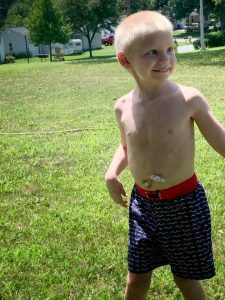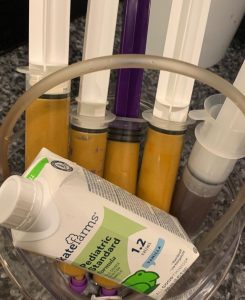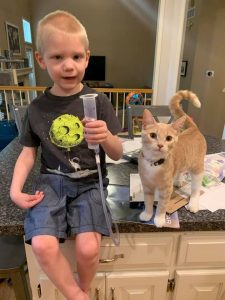We recently joined the ranks of families who have children with a feeding tube. We’ve been very open about this on social media and realized that people have lots of questions they’ve always been too nervous to ask…so I’m here to open up a dialogue and give you the basics!

Why does your child have a feeding tube?
This answer will vary for every family. In our case, our son has cerebral palsy and has trouble using his mouth and tongue efficiently. So, he can eat by mouth, but not enough to sustain healthy growth. Other reasons for feeding tubes include an unsafe swallow that causes aspiration into the lungs, anatomical differences in the digestive tract, heart defects, failure to thrive, extreme oral aversions, and severe reflux.
What did you do before you resorted to a feeding tube?
So many parents of “tubies,” as they’re affectionately known, have beaten themselves up for years trying to get their children to eat. In our case, we tried occupational therapy, feeding therapy, feeding groups with peers, speech therapy to strengthen his oral cavity, and prescription appetite stimulants to increase his desire to eat. None of them worked, and food and weight gain became a constant source of stress for us as parents. He did not gain any weight for roughly two years, from the ages of three to five.
Are all feeding tubes the same?

Nope! Feeding tubes can come in many forms. The most common you may have seen are N/G tubes (nasogastric tube, a temporary flexible catheter threaded through the nostril into a child’s stomach) and a G tube (gastrostomy tube, a surgically placed tube in the abdomen directly to the stomach that can be left in for as long as needed). Tubes can also be of the NJ, GJ, or J variety, where they are threaded past the stomach into the jejunum in the small intestine.
Does his tube hurt him?
I’ll be honest: Getting the tube placed wasn’t fun. Our son actually had two tubes placed, including one to remedy issues in his lower GI tract as well. He was in pain after the surgery, and it took a good ten days or so for his activity level to return to normal. While he was in the hospital, the staff did a great job with pain management and we kept him on Tylenol and Motrin when he was discharged. Now that his tube site (aka stoma) is healed, it doesn’t hurt him at all.
How long does a feeding take?
We are lucky in that our son does not have vomiting or reflux issues, so we use what is called a gravity bolus method of feeding. This means that we simply pour his formula into an open syringe, hold it above his stoma, and let the formula drain in. (I’ve explained it to friends as a beer bong of formula to the belly, which, while a bit crass, is true.) This takes us less than five minutes a feeding, including prep and getting him hooked up and disconnected! Some children need to be fed slowly due to issues with absorption and digestion; others may use a feeding pump for several hours a day.

What do you feed a tube fed child?
Again, it varies for every kid. You can purchase pre-made tube feeding formulas from a medical supply company, which is what we use. There are all different types for formulas, just like for infants — dairy free, soy free, allergen free, high calorie, reduced calorie, the list goes on and on! Many families also opt to blend their own food at home into liquids that can be given via tube.
What’s the hardest part of having a tube fed child?
Fighting with insurance and medical supply companies. We have to make sure to always have a stash of supplies like spare parts, tubing, gauze, formula, and syringes. It can be overwhelming to have to organize and coordinate it all to make sure you never run out.
Are there any risks or potential complications?
Other than the usual risks of a surgery, you need to carefully monitor a g-tube site for infection and granulation tissue. I happened to get a few piercings in my ears a few months before my son’s surgery, and it was surprisingly good preparation as the cleaning, monitoring, and maintenance was quite similar!
How can I support a friend whose child has a feeding tube?
First of all — Always be positive about the tube. It’s a medical device and helps kids immensely, which is a good thing! (Would you grimace if a child showed you their glasses?) Our son likes to show people his “buttons” and tell them about how “I got my buttons at the doctor!” The proper response is, “Cool!” or “Awesome! How do they work?” and not to look away or act horrified, sad, or disgusted. (Yes, I’ve had this happen.) Also, please don’t request a parent feeds their child in the bathroom or another room. Would you do that to any other toddler wanting a snack?
Second — Don’t ask “When are they getting it out?” Tubes can be a lifelong tool for many children, and that’s okay. Other kids may get their tubes out eventually, but it’s difficult to not get defensive as a parent when people seem to only want to know about when it will be gone.
Finally — Be open with your kids about it. Children are naturally curious about differences, so engaging them when they have questions will help them learn how to compassionately approach people with differences. A simple, “Some people eat through a tube in their belly like you eat through your mouth,” handles a whole lot of questions. I am always happy to answer questions from adults and kids that come from a place of support and curiosity.
And there you have it. A glimpse into our tubie life!















